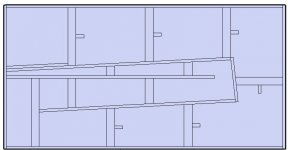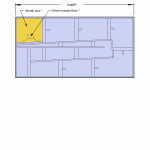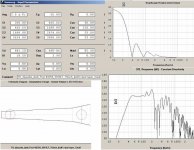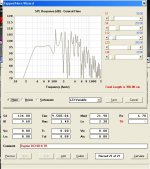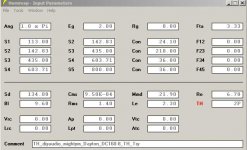Your guess is right. Its 160*82*38cm with 15mm walls, great as a bookshelf 🙂
What to tell about it? Its a satisfying experience. I planned to make 4 of these and put them together so that one big mouth is formed, but one allready makes more than enough noise (more than 4 of the drivers in small closed boxes - at least at the low end), so maybe i just keep it. I was a bit worried about the high compression ratio. To test this, i pushed maybe 50-100W (guessed by looking at the behringer amp status lights) into it at 18hz sine and with 15-60hz noise, which made several doors in our house rattle, but the cone didnt die of it. Yet, it produces a nice and totally unexpected air stream with large excursions. The driver i use has some noise from its suspension, more on the back side than on the front, but its masked well enough with music playing. Another thing is (i am not sure if it isnt just the "yay i have a big new sub" distortion of the mind), that the bass feels more dynamic compared to the closed box, especially short bursts of low noise, like drum bodies, are fun. Using bracing like you guys told me was definitely worth it. The enclosure is pretty much unaffected by the pressure. I made cross shaped bracing, as is indicated in the second pic. The folding was done in two iterations with volvotreters method. After the first folding, i measured the length, saw that it was about 30cm to short, added those and folded again.
Btw... can someone tell me how to stop my couch from shaking like crazy with the deep tones? Its like having a bass shaker. And i cant move out of the nearfield of it, or my room destroys the response.
What to tell about it? Its a satisfying experience. I planned to make 4 of these and put them together so that one big mouth is formed, but one allready makes more than enough noise (more than 4 of the drivers in small closed boxes - at least at the low end), so maybe i just keep it. I was a bit worried about the high compression ratio. To test this, i pushed maybe 50-100W (guessed by looking at the behringer amp status lights) into it at 18hz sine and with 15-60hz noise, which made several doors in our house rattle, but the cone didnt die of it. Yet, it produces a nice and totally unexpected air stream with large excursions. The driver i use has some noise from its suspension, more on the back side than on the front, but its masked well enough with music playing. Another thing is (i am not sure if it isnt just the "yay i have a big new sub" distortion of the mind), that the bass feels more dynamic compared to the closed box, especially short bursts of low noise, like drum bodies, are fun. Using bracing like you guys told me was definitely worth it. The enclosure is pretty much unaffected by the pressure. I made cross shaped bracing, as is indicated in the second pic. The folding was done in two iterations with volvotreters method. After the first folding, i measured the length, saw that it was about 30cm to short, added those and folded again.
Btw... can someone tell me how to stop my couch from shaking like crazy with the deep tones? Its like having a bass shaker. And i cant move out of the nearfield of it, or my room destroys the response.
MaVo said:Its a satisfying experience. I planned to make 4 of these and put them together so that one big mouth is formed, but one allready makes more than enough noise (more than 4 of the drivers in small closed boxes - at least at the low end), so maybe i just keep it. I was a bit worried about the high compression ratio. To test this, i pushed maybe 50-100W (guessed by looking at the behringer amp status lights) into it at 18hz sine and with 15-60hz noise, which made several doors in our house rattle, but the cone didnt die of it. Yet, it produces a nice and totally unexpected air stream with large excursions.
MaVo I'm very happy to hear about your results. I remember not so long ago you, Naudio, CLS and I were all engaged in some very "spirited" exchanges about the very things you wrote today. I was always telling you truth about my experiences with tapped horns. I'm just very happy you built one and can hear and observe the things I was trying to tell you guys about. I think now you can better understand what I was talking about back then. I still laugh about being accused of using a "midrange" driver in a tapped horn and being told it won't work. Well, those tapped horns are still playing quite well in my daughter's room.
http://www.diyaudio.com/forums/showthread.php?postid=1505236#post1505236
Rgs, JLH
Mavo_Beyma_TH
Hi Mavo,
Great data. Did you happen to run an impedance curve, and would you please post it if you did?
Regards,
Hi Mavo,
Great data. Did you happen to run an impedance curve, and would you please post it if you did?
Regards,
Thanks for sharing, Mavo.
Anyway, in my own studies, I was wondering how hard it would be to use multiple segments to try to represent a decent exponential flare. It isn't easy, it took several hours but I got lucky and it worked well enough on the first try. As shown it's about 36 x 18 inches. I wouldn't build it like that though, it would be easy enough to move the triangle of dead space way down to the other end and then all the angled boards could be much straighter.
So I'm just wondering if this is too many 180 degree bends. There are several segments in the bendy part that are quite close to 16 inches which puts them way out of the passband, but maybe when added up they could casue problems. Thoughts, please?
Anyway, in my own studies, I was wondering how hard it would be to use multiple segments to try to represent a decent exponential flare. It isn't easy, it took several hours but I got lucky and it worked well enough on the first try. As shown it's about 36 x 18 inches. I wouldn't build it like that though, it would be easy enough to move the triangle of dead space way down to the other end and then all the angled boards could be much straighter.
So I'm just wondering if this is too many 180 degree bends. There are several segments in the bendy part that are quite close to 16 inches which puts them way out of the passband, but maybe when added up they could casue problems. Thoughts, please?
An externally hosted image should be here but it was not working when we last tested it.
When you make the individual conical segments smaller, this mostly has influence on the higher frequencies. Yet, the higher frequencies will be in trouble in this design, due to the amount of bends.
MaVo said:When you make the individual conical segments smaller, this mostly has influence on the higher frequencies. Yet, the higher frequencies will be in trouble in this design, due to the amount of bends.
Can you predict at what frequency trouble will happen and how bad it might be? I'm not too worried about deep nulls up around 300 hz but don't need any inside the passband. Compared to a normal double fold (which has usually 3 180 degree turns and a bunch of 90's) how much worse is this?
Post #3271
Hi just_a_guy,
I was working on the same thing, basically trying to build something similar to the SPUD with a different geometry. By using the angled center board you end up with a bunch of short baffles, which are arranged at right angles to the outside, and the angled board. As there is a bit of data available now for the SPUD type enclosure a comparison may be possible to see the influence on the frequency response. That seems to be the only way you can get there, build something that "should" be acoustically equivalent to a well known, and measured enclosure, and compare the measured results.
Regards,
Hi just_a_guy,
I was working on the same thing, basically trying to build something similar to the SPUD with a different geometry. By using the angled center board you end up with a bunch of short baffles, which are arranged at right angles to the outside, and the angled board. As there is a bit of data available now for the SPUD type enclosure a comparison may be possible to see the influence on the frequency response. That seems to be the only way you can get there, build something that "should" be acoustically equivalent to a well known, and measured enclosure, and compare the measured results.
Regards,
Attachments
Good stuff, MaVo ... At one time PSW had Danley's horn profile drawing and spreadsheet results for his "perfect" LabHorn. Starting with this, one could trace his development of the final folding. There are more good posts in the PSW Archive.
John Sheerin has said "All the computer simulation in the world is useless if you don't actually build what you simulate." John has
good info, and some good links at:
http://ldsg.snippets.org/HORNS/design.html
For Just A Guy: The basic double folded horn has 2 - 180 degree bends and 2 - 90 degree bends. The driver being 90 degrees to
the axis of the horn at the throat, and the bend at the mouth have no effect.
For a tutorial on TH folding, see post #1490:
http://www.diyaudio.com/forums/showthread.php?s=&postid=1478209
Volvotreter's method will get you close enough, but you won't learn how to fold anything except that one double fold TH
configuration.
John Sheerin has said "All the computer simulation in the world is useless if you don't actually build what you simulate." John has
good info, and some good links at:
http://ldsg.snippets.org/HORNS/design.html
For Just A Guy: The basic double folded horn has 2 - 180 degree bends and 2 - 90 degree bends. The driver being 90 degrees to
the axis of the horn at the throat, and the bend at the mouth have no effect.
For a tutorial on TH folding, see post #1490:
http://www.diyaudio.com/forums/showthread.php?s=&postid=1478209
Volvotreter's method will get you close enough, but you won't learn how to fold anything except that one double fold TH
configuration.
Don Snyder said:
For a tutorial on TH folding, see post #1490:
http://www.diyaudio.com/forums/showthread.php?s=&postid=1478209
Volvotreter's method will get you close enough, but you won't learn how to fold anything except that one double fold TH
configuration.
This may be a wild idea, but i wonder if somehow David McBean's program can be taken to another step & maybe integrate folding diagrams / drawings??

Design help
I've simmed this driver: Dayton DC160-8. I'm trying to develop a small TH for music only that doesn't take up a lot of room.
My question, if i were to double the driver complement, what would I need to change on the input page?
I've simmed this driver: Dayton DC160-8. I'm trying to develop a small TH for music only that doesn't take up a lot of room.
My question, if i were to double the driver complement, what would I need to change on the input page?
Attachments
Post #3276
Hi mightym,
To maintain a similar frequency response you just double the cross-sectional areas, and adjust the drive level (8 Ohm v. 4 Ohm).
Hornresp takes care of the driver parameter changes.
Attached a quick try at this driver in Dual TH.
Regards,
Hi mightym,
To maintain a similar frequency response you just double the cross-sectional areas, and adjust the drive level (8 Ohm v. 4 Ohm).
Hornresp takes care of the driver parameter changes.
Attached a quick try at this driver in Dual TH.
Regards,
Attachments
Post #3273
Hi Mavo,
Thank you for posting the "danley labhorn posts" in Post #3273. I just got through reading them (it'll take a little longer to work through them). 🙂
Just great stuff. Oh ja, and thanks Tom D...
Regards,
Hi Mavo,
Thank you for posting the "danley labhorn posts" in Post #3273. I just got through reading them (it'll take a little longer to work through them). 🙂
Just great stuff. Oh ja, and thanks Tom D...
Regards,
Ciare 10NDH-3
I wanted to pass along to the group here another good tapped horn driver. The Ciare 10NDH-3 models very well. It also has pretty good bandwidth without needing an exttra inductor coil added. Stated Xmax is 8.5mm which is pretty good for a 10" woofer. My model is flat to 40Hz and -10dB at 25Hz. With some lining to the horn, usable bandwidth should be good up to about 165Hz. Size is pretty small at 84 liters. A pair of these should be able to rattle everything in your house. It's kind of pricey, but US Speaker puts almost every speaker on sale once or twice a year.
http://www.usspeaker.com/ciare 10ndh-3-1.htm
Rgs, JLH

I wanted to pass along to the group here another good tapped horn driver. The Ciare 10NDH-3 models very well. It also has pretty good bandwidth without needing an exttra inductor coil added. Stated Xmax is 8.5mm which is pretty good for a 10" woofer. My model is flat to 40Hz and -10dB at 25Hz. With some lining to the horn, usable bandwidth should be good up to about 165Hz. Size is pretty small at 84 liters. A pair of these should be able to rattle everything in your house. It's kind of pricey, but US Speaker puts almost every speaker on sale once or twice a year.
http://www.usspeaker.com/ciare 10ndh-3-1.htm
Rgs, JLH

Re: Design help
I've built some tapped horns using small drivers, and they run out of xmax in a hurry. It's something to keep in mind before you make any sawdust. Even with a small amp I can hear that tell-tale "cracking" sound as the woofer blows past it's excursion limits.
The Dayton only has 3mm of xmax, so be careful...
mightym said:I've simmed this driver: Dayton DC160-8. I'm trying to develop a small TH for music only that doesn't take up a lot of room.
My question, if i were to double the driver complement, what would I need to change on the input page?
I've built some tapped horns using small drivers, and they run out of xmax in a hurry. It's something to keep in mind before you make any sawdust. Even with a small amp I can hear that tell-tale "cracking" sound as the woofer blows past it's excursion limits.
The Dayton only has 3mm of xmax, so be careful...
- Home
- Loudspeakers
- Subwoofers
- Collaborative Tapped horn project
